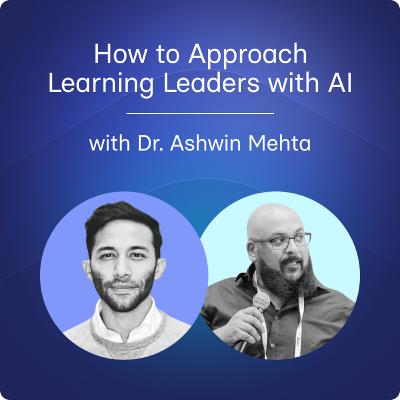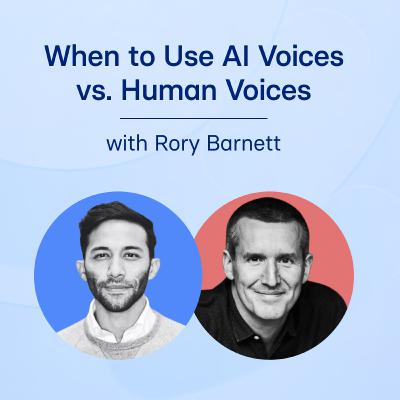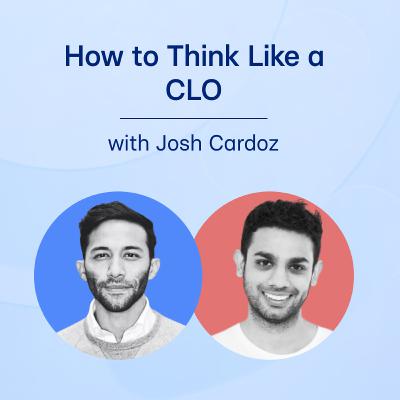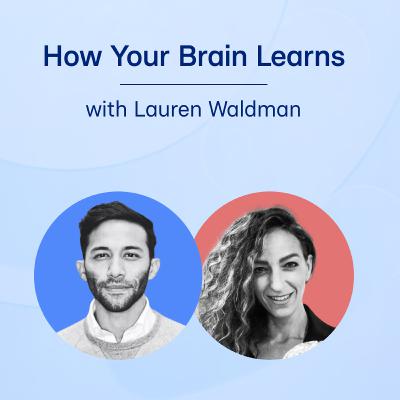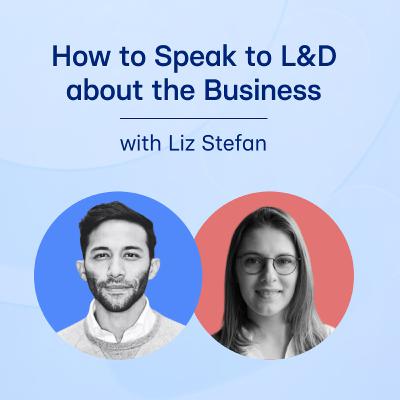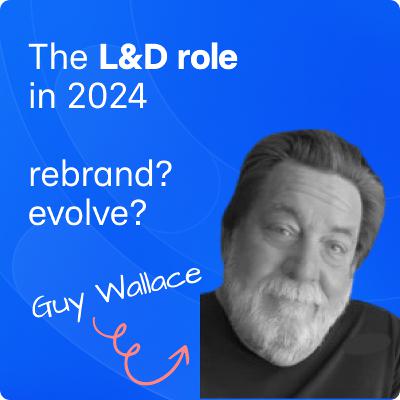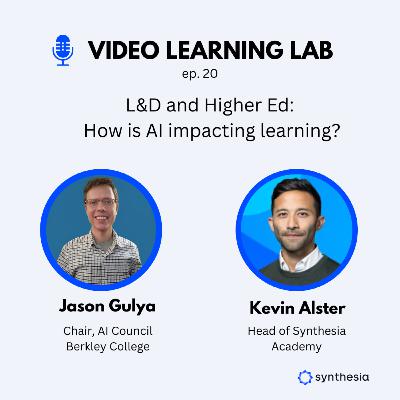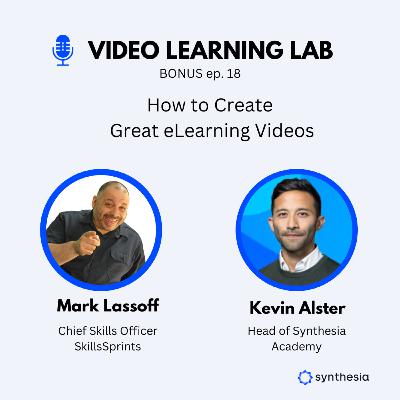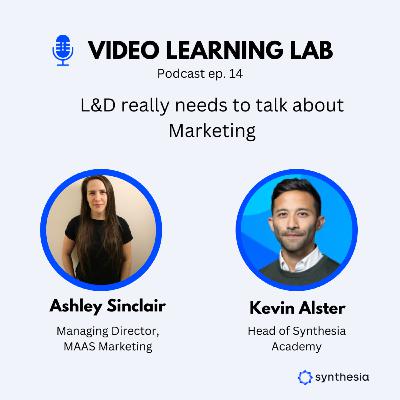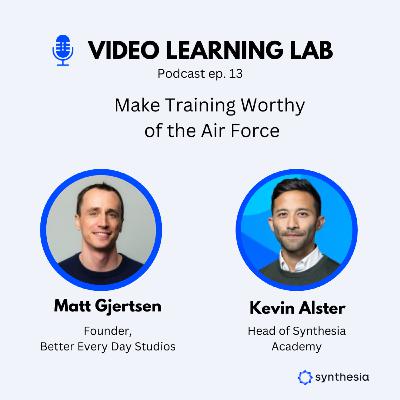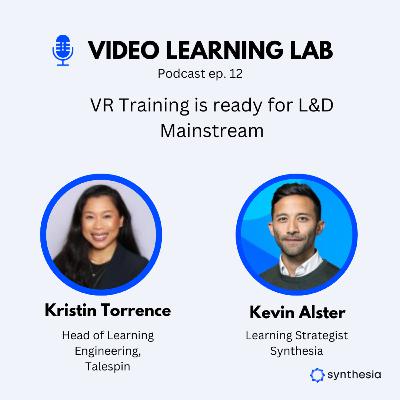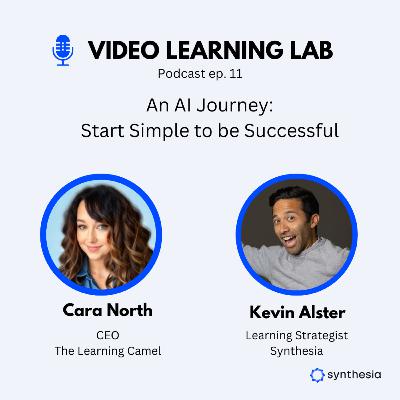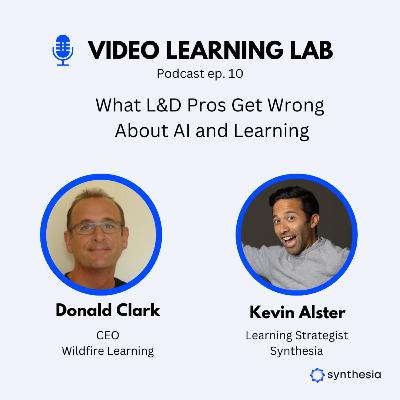Discover Video Learning Lab
Video Learning Lab

Video Learning Lab
Author: Video Learning Lab
Subscribed: 1Played: 12Subscribe
Share
© Video Learning Lab
Description
Welcome to Video Learning Lab, your go-to podcast for elevating your Learning & Development (L&D) and video creation skills.
Designed for L&D professionals and video creators like you, we bring you interviews with industry experts at the apex of their game.
Discover cutting-edge strategies, the latest tools, and proven techniques to enhance your craft.
From interactive e-learning solutions to compelling video content, we've got you covered.
Subscribe now to stay ahead of the curve and transform the way you educate and engage.
Designed for L&D professionals and video creators like you, we bring you interviews with industry experts at the apex of their game.
Discover cutting-edge strategies, the latest tools, and proven techniques to enhance your craft.
From interactive e-learning solutions to compelling video content, we've got you covered.
Subscribe now to stay ahead of the curve and transform the way you educate and engage.
27 Episodes
Reverse
In this episode Lavinia and Kevin discuss what's actually the value of AI tools for L&D. The surprising part? It's not about LLMs and AI-enabled tools, but rather it's about automation and freeing up your time for higher value tasks.
Highlights:
1:24 - What is actually different about NOW with AI?
6:09 - L&D teams acquire these very complex LMSes
11:31 - L&D teams is that they're stuck with operational tasks
17:15 - Looking for automation opportunities at OffBeat
22:34 - Lavinia's process looking for opportunities
28:10 - 3 Hot Seat Questions
📚 Resources:
Connect with Lavinia on LinkedIn: Lavinia Mehedintu
Join OffBeat: Offbeat.works
Sana Labs Article: Link
Lavinia Mehedintu has been designing learning experiences and career development programs for the past 9 years both in the corporate world and in higher education. As a Co-Founder and Learning Architect @Offbeat she's applying adult learning principles so that learning & people professionals can connect, collaborate, and grow.
- -
🤔 About the Host
Kevin Alster leads the learning team at Synthesia, focusing primarily on product education and client services. With over a decade of experience in education and learning, Kevin has transitioned from the classroom into tech to help people communicate better through video. He has crafted enterprise and branded learning solutions for organizations like General Assembly, The School of The New York Times, and Sotheby’s Institute of Art.
🧑🏽🏫 Discover the Synthesia Academy: Synthesia Academy 🗣Connect with Kevin on LinkedIn: Kevin Alster
Dr. Ash Mehta is a visionary in learning technology, passionate about transforming enterprise learning through innovative, immersive, and gamified experiences that yield measurable outcomes. With a mission to create personalized, engaging learning environments, Ash develops strategies that leverage the latest technologies, including AI, to stimulate knowledge and skill development effectively.
In our conversation, we explore the influence of AI on learning, the science behind personalized learning, and his approach to designing transformational learning solutions.
Chapters:
0:13 - Intro1:28 - Where AI and L&D is now4:53 - How to approach AI solutions in L&D12:26 - What companies get out of AI video18:56 - Example of AI Strategy in Work25:48 - Where AI Agents play a role in AI strategy31:08 - The real potential of AI Agents in experiences
41:27 - Ash's 3 rapid fire questions
📚 Resources:
Connect with Ash on LinkedIn: Dr. Ash Mehta
Learn More About Ash’s Work: https://mehtadology.com/
- -
🤔 About the Host
Kevin Alster leads the learning team at Synthesia, focusing primarily on product education and client services. With over a decade of experience in education and learning, Kevin has transitioned from the classroom into tech to help people communicate better through video. He has crafted enterprise and branded learning solutions for organizations like General Assembly, The School of The New York Times, and Sotheby’s Institute of Art.
🧑🏽🏫 Discover the Synthesia Academy: Synthesia Academy 🗣Connect with Kevin on LinkedIn: Kevin Alster
Fei Wu is a Chinese-American video marketing expert and virtual event strategist who helps creators and businesses transform their visions into impactful digital brands. Specializing in video content, she supports small business owners in showcasing their products and services, while leveraging YouTube and podcast strategies to expand their customer base.
In our conversation we talk about the impact of AI tools on creators, her journey to cracking the code on YouTube, and most importantly how to tackle the creative process.
Chapters:
0:00 - Intro
4:45 - The US/UK vs. the Asian tech experience
8:07 - The impact of AI on creator tools
14:59 - Feisworld - the audience, the creation story
25:03 - The key to success - breaking down the process
32:20 - The key to success - finding drive and motivation
37:12 - What are 3 healthy challenges to help you get started?
📚 Resources:
Fei's World YouTube Channel:
https://www.youtube.com/@FeisworldMedia
Connect with Fei on LinkedIn:
https://www.linkedin.com/in/feiwu/
Find out more about Fei's Services:
https://www.feisworld.com/
____
🤔 About the Host
Kevin Alster leads the learning team at Synthesia focusing primarily on product education and client services.
With over a decade of experience in education and learning, he has moved from the classroom and into tech to help people create and communicate better through video. He has been developing enterprise and branded learning solutions in organizations such as General Assembly, The School of The New York Times, and Sotheby’s Institute of Art.
____
🧑🏽🏫 Check out the Synthesia Academy here:
https://www.synthesia.io/academy 🗣
Or get in touch with me on LinkedIn
https://www.linkedin.com/in/kevinalster/
____
Rory Barnett is an accomplished British voiceover artist with over six years of full-time experience, bringing a rich background as a BBC radio presenter, reporter, and newsreader. Based in London, Rory specializes in bringing scripts to life from his personal studio, leveraging his extensive media experience to enhance diverse voice projects.
Chapters:
0:00 - Intro
6:22 - Radio and Other Broadcast Journalism
11:35 - The Range of Work of a Voiceover Artist
16:32 - How does a voiceover artist turn words on page into the recording?
21:44 - What should change about how we present eLearning content?
29:32 - How does a voiceover artist view AI voices?
36:22 - Rory's tip for amateur voiceover artists
📚 Resources:
Rory's 2021 interview:
https://rorybarnett.com/on-air-duel-with-audiobook-ai-narrator/
Connect with Rory on LinkedIn:
https://www.linkedin.com/in/rory-barnett-voiceover/
✉ Email: rory@rorybarnett.com🌐 Website: http://www.rorybarnett.com 👍 Facebook: www.facebook.com/rory.barnett.148💻 Twitter: @rorybarnettvo
____
🤔 About the Host
Kevin Alster leads the learning team at Synthesia focusing primarily on product education and client services.
With over a decade of experience in education and learning, he has moved from the classroom and into tech to help people create and communicate better through video. He has been developing enterprise and branded learning solutions in organizations such as General Assembly, The School of The New York Times, and Sotheby’s Institute of Art.
____
🧑🏽🏫 Check out the Synthesia Academy here:
https://www.synthesia.io/academy 🗣
Or get in touch with me on LinkedIn
https://www.linkedin.com/in/kevinalster/
____
Josh Cardoz, Chief Creative & Learning Officer at Sponge Group, a global leader in digital learning. He has an extensive background in digital learning strategy, execution, and team upskilling.
Chapters:
0:00 - Intro
5:33 - From Instructional Designer to CLO
13:47 - Learning is always the medium not the end
16:18 - Let's not waste people time
21:18 - Always identify the compelling question
27:09 - How does a CLO think about digital tools compared to you?
35:48 - AI's impact on quality of experience
____
🤔 About the Host
Kevin Alster leads the learning team at Synthesia focusing primarily on product education and client services.
With over a decade of experience in education and learning, he has moved from the classroom and into tech to help people create and communicate better through video. He has been developing enterprise and branded learning solutions in organizations such as General Assembly, The School of The New York Times, and Sotheby’s Institute of Art.
____
🧑🏽🏫 Check out the Synthesia Academy here:
https://www.synthesia.io/academy 🗣
Or get in touch with me on LinkedIn
https://www.linkedin.com/in/kevinalster/
____
Lauren stands as a distinguished Learning Scientist, known for her expertise and groundbreaking contributions to the field of Learning and Development. With a formidable triple certification in Neuroscience, she navigates the intricate pathways of cognition with unparalleled precision.
Her journey is one of relentless pursuit and unwavering dedication and advocation to evolve the way we learn and grow as human beings.
In the realm of Learning and Development, Lauren's name is synonymous with innovation and excellence. Her insights transcend conventional boundaries, reshaping paradigms and inspiring transformative change.
Chapters:
0:00 - Intro
4:28 - Using focus to get learners to understand their brains
8:34 - Some learning myths about the brain that should stop
12:00 - How does your brain work (explained with visuals)
22:13 - How do you deal with stakeholders who need to learn more about the brain?
29:00 - How can we use neuroscience research to better evaluate what sticks for learners?
33:12 - The importance of informal assessment and "at bats"
42:35 - What is the starting point for if you want to learn more about neuroscience?
📚 Resources:
Connect with Lauren on LinkedIn: https://www.linkedin.com/in/lauren-waldman-learning-pirate-4666bab/
Joining Forces with Your Brain: https://www.learningpirate.com/joining-forces-with-your-brain
____
🤔 About the Host
Kevin Alster leads the learning team at Synthesia focusing primarily on product education and client services.
With over a decade of experience in education and learning, he has moved from the classroom and into tech to help people create and communicate better through video. He has been developing enterprise and branded learning solutions in organizations such as General Assembly, The School of The New York Times, and Sotheby’s Institute of Art.
____
🧑🏽🏫 Check out the Synthesia Academy here:
https://www.synthesia.io/academy 🗣
Or get in touch with me on LinkedIn
https://www.linkedin.com/in/kevinalster/
____
Liz Stefan currently serves as the CEO and co-founder of Nifty Learning, which helps companies save 20% of their training budgets and turn training costs into strategic investments. She brings her experience working in Fortune 500 companies through Xerox helping to develop scaled enterprise solutions for her clients.
Chapters:
0:00 - Intro
1:40 - Reimagining the L&D field and changing its image
7:35 - How to get L&D to speak to the business
12:12 - Bringing Product Mindset into L&D
26:14 - Where has L&D done well? What examples can we pull?
34:55 - How would you rewrite the job description of a future L&D?
📚 Resources:
Connect with Liz on LinkedIn: https://www.linkedin.com/in/elisaletitiastefan/
____
🤔 About the Host
Kevin Alster leads the learning team at Synthesia focusing primarily on product education and client services. With over a decade of experience in education and learning, he has moved from the classroom and into tech to help people create and communicate better through video. He has been developing enterprise and branded learning solutions in organizations such as General Assembly, The School of The New York Times, and Sotheby’s Institute of Art.
____
🧑🏽🏫 Check out the Synthesia Academy here:
https://www.synthesia.io/academy 🗣
Or get in touch with me on LinkedIn
https://www.linkedin.com/in/kevinalster/
____
Guy W. Wallace is a retired Performance Analyst and Instructional Architect (as of July 2023) and had been designing and developing performance-based Instruction - Performance Guides & Learning Experiences - for Enterprise Learning functions and their business-critical target audiences since 1979.
____
Chapters
2:32 - Why is Performance critical for L&D?
10:55 - What is the difference between education vs. training?
21:02 - Bringing the business mindset to L&D
30:27 - What's the cost of doing nothing? Framing consequences
35:13 - The critical question to ask your stakeholders
46:00 - What DO we call the L&D role of the future?
____
🖐🏽 Key Takeaways:
1. L&D is poor at delivering outcomes because there's too much focus placed on delivering content and too much on behaviors. Both are necessary for a quality experience...but they are the drivers of those outcomes.
2. L&D is missing the business mindset and the language of business that helps us to connect with our stakeholders. We should be looking to frame our business case for our training by framing our outcomes in terms that our stakeholders can understand.
3. Ask the question: "What would authentic practice look like?"
This helps stakeholders to understand transfer; it helps you to create effective practice; it ensures that everyone is aligned for both the timeline and evaluation for the success of your program.
____
📚 Resources:
Connect with Guy on LinkedIn: https://www.linkedin.com/in/guywwallace/
Books written by Guy:
https://www.amazon.com/stores/Guy%20W.%20Wallace/author/B08JQC4C4V
____
🤔 About the Host
Kevin Alster leads the learning team at Synthesia focusing primarily on product education and client services.With over a decade of experience in education and learning, he has moved from the classroom and into tech to help people create and communicate better through video.He has been developing enterprise and branded learning solutions in organizations such as General Assembly, The School of The New York Times, and Sotheby’s Institute of Art.
____
🧑🏽🏫 Check out the Synthesia Academy here:
https://www.synthesia.io/academy 🗣
Or get in touch with me on LinkedIn
https://www.linkedin.com/in/kevinalster/
____
Jason Gulya is an AI Strategist in higher education. Transforming initial skepticism about AI into advocacy, he now focuses on integrating AI into educational workflows. His expertise has guided numerous educators and institutions in harnessing AI for personalized and effective teaching.
____
Chapters
1:16 - How similar are L&D and Higher Education?
7:22 - How has Gen AI changed the first semester with ChatGPT?
13:48 - How are we training educators to get ready for AI?
28:14 - How do LLMs shorten the skills gap for new adopters?
32:24 - What does the new bachelor's degree look like with AI as a skill?
____
🖐🏽 Key Takeaways:
1. AI is going to shine a light on what has been broken for years in education.
2. First, we should focus on educating people on the use and workings of LLMs and AI tech. Then when people understand the technology a bit better and what it can do...then we can focus on strategy.
3. Where AI is a boon for learning is not only being able to create a product that is more complete and supplements the skills a learner doesn't have...but also for students to then be able to reflect on the process that led them to the product.
____
📚 Resources:
Connect with Jason on LinkedIn: https://www.linkedin.com/in/jason-gulya/____
🤔 About the Host
Kevin Alster leads the learning team at Synthesia focusing primarily on product education and client services.With over a decade of experience in education and learning, he has moved from the classroom and into tech to help people create and communicate better through video.He has been developing enterprise and branded learning solutions in organizations such as General Assembly, The School of The New York Times, and Sotheby’s Institute of Art.
____
🧑🏽🏫 Check out the Synthesia Academy here:
https://www.synthesia.io/academy 🗣
Or get in touch with me on LinkedIn
____
Today, I'm speaking with Mark Lassoff, the Chief Skills Officer at SkillSprints. He has been a frequent presenter and taught workshops on his approaches to Digital Learning. His company Framework Tech has educated more than 2.6 million individuals in digital skills.
He's also the recent author of "The Ulimate Guide to Creating Online Learning Video: A Comprehensive Handbook for Instructional Designers."
____
Chapters
01:24 - What were the biggest conversations at DevLearn this year?
11:14 - What are the core concepts of instructional video that every designer should know?
19:19 - What makes an online learning video compared to just any other video?
27:11 - What is the most effective way to engage viewers through video?
31:24 - What can we take from TikTok videos and how can we apply that to learning video?
37:33 - What's the best advice for getting started in creating learning videos?
____
🖐🏽 Key Takeaways:
1. Every learning video should have just one learning objective. If you have more than one learning objective in a video...make another video!
2. Thorough pre-production planning is crucial for efficient and effective video production. Time invested in pre-production can significantly save time during the actual production and post-production phases.
3. Start creating videos knowing that initial attempts might not be perfect but they are essential for learning and improvement in video production skills.
4. Observe successful content creators on platforms like YouTube and TikTok. You can pick up various techniques and styles, helping you develop your own unique approach to video production.
____
📚 Resources:
Connect with Mark on LinkedIn: https://www.linkedin.com/in/marklassoff/
The Ulimate Guide to Creating Online Learning Video: A Comprehensive Handbook for Instructional Designers:
https://www.amazon.com/Ultimate-Guide-Creating-Online-Learning/dp/B0CF4LJCNH
____
🤔 About the Host
Kevin Alster leads the learning team at Synthesia focusing primarily on product education and client services.
With over a decade of experience in education and learning, he has moved from the classroom and into tech to help people create and communicate better through video.
He has been developing enterprise and branded learning solutions in organizations such as General Assembly, The School of The New York Times, and Sotheby’s Institute of Art.
____
🧑🏽🏫 Check out the Synthesia Academy here:
https://www.synthesia.io/academy 🗣
Or get in touch with me on LinkedIn
____
Today, we're featuring Nelson Sivalingam, an innovative leader and the CEO and Co-founder of HowNow. He has masterminded a global learning platform dedicated to providing employees with timely and necessary learning resources. Known for his focus on enhancing performance and personal development, Nelson is a frequent presence at industry conferences and a respected voice in the field. His contributions have earned him recognition as one of the top Asian Stars in Tech by KPMG.
Additionally, Nelson has written the insightful book "Learning at Speed," which offers strategies on upskilling and reskilling workforces rapidly to boost business performance.
____
Chapters
01:31 - What's the big topic with AI and L&D at the moment?
11:07 - AI has been in L&D for some time, not just recently
14:55 - What is Learning at Speed?
20:01 - What team is the best fit for the Lean Learning Method?
26:49 - How do we change the company's perception of L&D?
31:30 - 3 Things L&D teams need to let go of
____
🖐🏽 Key Takeaways:
1. Learning at speed is about applying product methodology and mindset to creating learning that the organization actually wants.
2. L&D and startups are very similar in how they develop their product because there's an urgency to figure out what is your product before you run out of money.
3. L&D needs to find a way to make their language universal to the business – which can be done by applying the lean learning methodology. If we speak the language of the business, we can get more support for our learning initiatives.
4. L&D needs to be measured in approaching a solution. We have our tools of training, courses, or other resources – but we could spend more time on finding the solution that actually fits the problem we're trying to understand.
____
📚 Resources:
Connect with Nelson on LinkedIn: https://www.linkedin.com/in/nelsonsivalingam/
Learning at Speed:
https://www.amazon.com/Learning-Speed-Workforce-Business-Performance/dp/1398603104
Learning Canvas:
(MIRO) https://miro.com/miroverse/the-learning-canvas/?social=copy-link
____
🤔 About the Host
Kevin Alster leads the learning team at Synthesia focusing primarily on product education and client services.
With over a decade of experience in education and learning, he has moved from the classroom and into tech to help people create and communicate better through video.
He has been developing enterprise and branded learning solutions in organizations such as General Assembly, The School of The New York Times, and Sotheby’s Institute of Art.
____
🧑🏽🏫 Check out the Synthesia Academy here:
https://www.synthesia.io/academy 🗣
Or get in touch with me on LinkedIn
____
Markus Bernhardt is a Fellow of the Learning Performance Institute and a member of several prestigious councils, including the Forbes Technology Council and the HBR Advisory Council. A leading voice in the global learning and HR landscape, he is an author, speaker, and panelist. Recently, he was the chief evangelist at OBRIZUM, where he merged cognitive science with digital learning and AI.
____
0:00 - Introduction
0:49 - What was different about this year compared to past years?
2:16 - What were the big takeaways from this year's conference?
4:24 - Why has no one yet mastered AI application to work?
7:03 - What emerging tech or tools will impact learner experience?
10:42 - What skills will L&D teams need to deliver on in 2024?
14:37 - What was the biggest takeaway from the AI symposium?
____
🖐🏽 Key Takeaways:
1. Everyone is still experimenting but no one has a strategy for how to leverage AI meaningfully for work (yet).
2. Read the terms and conditions of your AI tools! A lot of them are safer than you might thing.
____
📚 Resources:
Connect with Markus on LinkedIn: https://www.linkedin.com/in/markus-bernhardt/
____
🤔 About the Host
Kevin Alster leads the learning team at Synthesia focusing primarily on product education and client services.
With over a decade of experience in education and learning, he has moved from the classroom and into tech to help people create and communicate better through video.
He has been developing enterprise and branded learning solutions in organizations such as General Assembly, The School of The New York Times, and Sotheby’s Institute of Art.
____
🧑🏽🏫 Check out the Synthesia Academy here:
https://www.synthesia.io/academy 🗣
Or get in touch with me on LinkedIn
____
Josh Cavalier is a leading figure in Learning & Development with nearly 30 years of experience. Specializing in the application of Generative AI frameworks like ChatGPT, he offers innovative solutions for corporations, government agencies, and educational institutions. Josh shares his wealth of knowledge through a popular YouTube channel focused on Generative AI tips and tricks.
____
Chapters
02:02 - Is now the time to start using video?
06:07 - This is the reason you need to learn prompt engineering
10:40 - Don't wait to start experimenting with AI content creation
19:27 - Has AI made a big splash this year...or not yet?
27:22 - Why do training videos look so old, if the tech is so new?
36:54 - How training has changed from old to new
45:32 - Closing words from Josh
____
🖐🏽 Key Takeaways:
1. The world of AI tech is changing overnight. Those who are experimenting now will be able to keep up later.
2. We're all waiting to figure out what to do with AI in our lives and work, especially when it comes to LLMs.
3. Both training experiences and audiences have changed. We're in a fist fight for attention and it's up to training designers to create more engaging, more useful experiences.
____
📚 Resources:
Connect with Josh on LinkedIn: https://www.linkedin.com/in/joshcavalier/
Josh's ChatGPT Masterclass: https://www.joshcavalier.com/chatgpt-for-learning-development-masterclass
____
🤔 About the Host
Kevin Alster leads the learning team at Synthesia focusing primarily on product education and client services.
With over a decade of experience in education and learning, he has moved from the classroom and into tech to help people create and communicate better through video.
He has been developing enterprise and branded learning solutions in organizations such as General Assembly, The School of The New York Times, and Sotheby’s Institute of Art.
____
🧑🏽🏫 Check out the Synthesia Academy here:
https://www.synthesia.io/academy 🗣
Or get in touch with me on LinkedIn
____
Ashley Sinclair is the Managing Director at MAAS Marketing and has spent almost ten years working in marketing for the learning and development (L&D) sector. She encourages people in L&D to use marketing techniques to improve their work, and also co-hosts a podcast called Marketing for Learning to share ideas on how to make L&D better.
____
Chapters
00:00 - Ashley's intro and snowboarding
05:08 - L&D is wasting it's budget on useless resources
09:27 - Marketing for learning is the same as marketing for products
14:45 - Start by auditing what's in your resource library
20:08 - Building out a marketing plan
32:33 - Wrapping up the process of building a marketing plan
45:15 - Pro tip: forget training and think about the people
____
🖐🏽 Key Takeaways:
1. L&D has a huge need for marketing within the organization. Employees often don't know about certain resources that are available because this hasn't been clearly communicated to them.
2. Drop the assumption that employees want to learn and will be able to help themselves. L&D needs to understand their audience and develop solutions that meet that need.
3. Take stock of the instructional resources that are available and understand what the experience is like for your users. This is an easy opportunity to assess what is working, what can go, and what needs updating.
____
📚 Resources:
Connect with Ashley on LinkedIn: https://www.linkedin.com/in/ashsinclair/
MAAS Marketing: https://www.maas-marketing.co.uk/
____
🤔 About the Host
Kevin Alster leads the learning team at Synthesia focusing primarily on product education and client services.
With over a decade of experience in education and learning, he has moved from the classroom and into tech to help people create and communicate better through video.
He has been developing enterprise and branded learning solutions in organizations such as General Assembly, The School of The New York Times, and Sotheby’s Institute of Art.
____
🧑🏽🏫 Check out the Synthesia Academy here:
https://www.synthesia.io/academy 🗣
Or get in touch with me on LinkedIn
____
Matt Gjertsen is the founder and Chief Learning Officer of Better Every Day Studios, a firm specializing in instructional design for aerospace and defense companies. With a background as an Instructor Pilot in the U.S. Air Force and a Manager of Training and Development at SpaceX, Matt brings a wealth of experience in training and development.
In this episode, we spoke about how Matt's background and development as an Air Force Training Pilot have helped him to craft no-nonsense training programs for his clients.
____
Chapters
00:00 - Matt's Intro and Failing into Training
04:42 - How do increase the rigor of your training?
11:58 - Surround your participants with your training topic
17:05 - Focus on Behavior vs. Knowledge for Effective Training
22:16 - Example: How to uncover key behaviors for training
27:55 - What cognitive load actually looks like
37:54 - Relationships are key to giving good feedback
____
🖐🏽 Key Takeaways:
1. To focus on performance, you need to identify the behavior that you will need to see to know the training was successful.
2. Immerse your participants in your training experience, not just in the time you have with them. Send out resources with different formats, give them primers for your next workshop, and help them to fall in love with the problems you're trying to solve.
3. Don't give feedback unless you can say that you care about the other person's development.
____
📚 Resources:
Connect with Matt on LinkedIn: https://www.linkedin.com/in/matthewgjertsen/
Better Every Day Studios: https://www.bettereverydaystudios.com/
____
🤔 About the Host
Kevin Alster leads the learning team at Synthesia focusing primarily on product education and client services.
With over a decade of experience in education and learning, he has moved from the classroom and into tech to help people create and communicate better through video.
He has been developing enterprise and branded learning solutions in organizations such as General Assembly, The School of The New York Times, and Sotheby’s Institute of Art.
____
🧑🏽🏫 Check out the Synthesia Academy here:
https://www.synthesia.io/academy 🗣
Or get in touch with me on LinkedIn
____
Kristin Torrence is helping to bring VR scenarios and training into the mainstream at CA-based company, Talespin. As the Head of Learning Engineering, she focuses on the development of targeted skills through the designing VR scenarios.
In this episode, we spoke about how Kristin approaches VR learning experience design, what types of performance are the perfect fit for VR, and how to evaluate the effectiveness of an employee going through training.
____
Chapters
00:00 - What is Learning Engineering?
07:44 - What's the current state of VR and training?
11:22 - How VR content has evolved for L&D
18:12 - What type of instruction is FIT for VR?
22:15 - How do you give good feedback in VR training?
34:30 - How do you design a virtual human to give feedback?
41:14 - How to use ChatGPT to develop better scenarios
____
🖐🏽 Key Takeaways:
1. VR training allows for more realistic, repeatable, and immersive scenarios that more closely mimic real-life situations and experience that classroom training can't.
2. Two types of feedback that are key to designing VR training are formative and summative assessments. You want to assess skill-building in progress as well as report back the overall progress towards a performance goal.
3. Define the skills, align the decision-points, and then provide multiple pathways to the "best" solution. Employees won't get the right solution every single time, but there should be opportunities to recover "wrong" choices and get back to the same positive outcome.
____
📚 Resources:
IEEEVR: Professional organization committed to the development of Learning Engineering as a profession and as an academic discipline.
Talespin: Kristin's company dedicated towards building VR solutions for the Future of Work.
____
🤔 About the Host
Kevin Alster leads the learning team at Synthesia focusing primarily on product education and client services.
With over a decade of experience in education and learning, he has moved from the classroom and into tech to help people create and communicate better through video.
He has been developing enterprise and branded learning solutions in organizations such as General Assembly, The School of The New York Times, and Sotheby’s Institute of Art.
____
🧑🏽🏫 Check out the Synthesia Academy here:
https://www.synthesia.io/academy 🗣
Or get in touch with me on LinkedIn
____
Cara North is one of the most recognized named in Instructional Design both for effective Instructional Design practices and getting a solid start in the industry. She is the founder of The Learning Camel and the author of "Learning Experience Design Essentials."
In this episode, we spoke all about how Cara got her start as an Instructional Designer as well as how to make practical use of AI avatars in your learning resources.
____
Chapters
00:00 - Intro and Cara's start in Instructional Design
05:17 - Moving from Trainee to Trainer
09:32 - Seek Out Opportunities for Better Projects as an Entry-Level ID
16:20 - Being Proactive and not Reactive in L&D
25:12 - How Cara uses AI Avatars in Training
37:00 - Designing a Learning Journey
45:00 - How to Experiment with New AI Tools
____
🖐🏽 Key Takeaways:
1. Social Equity is an instructional designer's super power for getting things done within the business. Who you meet and who you know can help you answer questions, provide context, or be your champion!
2. AI avatars are a way to bring learning design to life.
3. When learning to use instructional design tools, you don't need to reinvent the wheel, but you should find something to base your content around like a nearby book or favorite blog article.
4. Don't just reach for AI tools. Identify a particular problem you're looking to solve and then find the right AI solution to test.
____
📚 Resources:
Cara's book "Learning Experience Design Essentials: Amazon
Connect with Cara North: LinkedIn
The Learning Camel (consulting service): Click here
____
🤔 About the Host
Kevin Alster leads the learning team at Synthesia focusing primarily on product education and client services.
With over a decade of experience in education and learning, he has moved from the classroom and into tech to help people create and communicate better through video.
He has been developing enterprise and branded learning solutions in organizations such as General Assembly, The School of The New York Times, and Sotheby’s Institute of Art.
____
🧑🏽🏫 Check out the Synthesia Academy here:
https://www.synthesia.io/academy 🗣
Or get in touch with me on LinkedIn
____
Donald Clark is one of the most well-known experts on bringing AI into Learning and Instruction. He's the former CEO of Epic Group plc, and current CEO of AI learning company WildFire.
In this episode, we spoke all about why L&D can't seem to nail the right problems for the business and their failed approach to making learning happen.
And of course...how we could fix it.
____
Chapters
0:00 - Intro and Donald's background
2:47 - The early beginnings of learning technologies
5:47 - Turning yourself into an AI model with Synthesia
9:18 - The role of AI avatars in performance support
13:39 - Why is AI such a boon for learning?
20:32 - The Big Problem with Workplace Learning
25:52 - What are the skills that L&D needs to have to survive?
33:37 - The role of dialogue and intelligence and language
____
🖐🏽 Key Takeaways:
1. Learning is a process and L&D needs to remember learning science if it wants to drive new behavior and results. Training as an event is dead.
2. AI avatars provide a face and a voice for the content that gets generated. We'll need something to interact with.
3. People are missing the point of ChatGPT in being a program for learning through dialogue.
4. The Future of AI in Learning and Development is performance support...not more content.
____
📚 Resources:
Donald's blog: http://donaldclarkplanb.blogspot.com/
Connect with Donald: LinkedIn
Great Minds on Learning Podcast: Link to show
____
🤔 About the Host
Kevin Alster leads the learning team at Synthesia focusing primarily on product education and client services.
With over a decade of experience in education and learning, he has moved from the classroom and into tech to help people create and communicate better through video.
He has been developing enterprise and branded learning solutions in organizations such as General Assembly, The School of The New York Times, and Sotheby’s Institute of Art.
____
🧑🏽🏫 Check out the Synthesia Academy here:
https://www.synthesia.io/academy 🗣
Or get in touch with me on LinkedIn
____
Ross Stevenson is the creator of the L&D newsletter Steal These Thoughts.
He's a seasoned learning and performance strategist helping to build world-class learning functions for global organizations.
His expertise lies in designing digital-first learning content strategies, fusing marketing techniques with learning principles, and crafting top-notch digital content tools.
In this episode, we spoke all about why employees don't engage with Learning Team initiatives and what we can do about that.
____
🖐🏽 Key Takeaways:
Part of the reason there's such a gap between L&D and the rest of the organization is because of limitations set by the organization on how to measure learning (incorrectly).
Always finish your learning design with an engagement plan. Go back to the strategies that you used to conduct an analysis for a learning problem and use those to retarget your learners.
If you're running a lean L&D team and want to measure impact (but don't have the time/capacity) consider using the BAR framework – see resources.
____
📚 Resources:
BAR framework: https://stealthesethoughts.com/2023/04/19/how-to-get-useful-product-feedback/
Steal These Thoughts website: https://stealthesethoughts.com/
Ross's ebook on playing the career game: https://mybook.to/Af6Yr
____
🤔 About the Host
Kevin Alster leads the learning team at Synthesia focusing primarily on product education and client services.
With over a decade of experience in education and learning, he has moved from the classroom and into tech to help people create and communicate better through video.
He has been developing enterprise and branded learning solutions in organizations such as General Assembly, The School of The New York Times, and Sotheby’s Institute of Art.
____
🧑🏽🏫 Check out the Synthesia Academy here: https://www.synthesia.io/academy
🗣 Or get in touch with me on LinkedIn: https://www.linkedin.com/in/kevinalster
Chapters:
00:00- Introduction
08:36- The Gap Between L&D and Learners
20:02- How to Measure if You Have a Lean Team
26:57- Why Digital Tools Don't Get Adopted
29:32- How Do You Create an Engagement Plan
40:15- The Product Mindset in L&D
Dr. Kuva Jacobs is the Founding Director of the Redpoint Consulting Firm and the creator of the LinkedIn Group Learning Myth Busters.
She helps to drive to create innovative learning solutions in the corporate space, where she contributes to a wide range of learning & development projects, across all stages of their lifecycle.
____
🖐🏽 Key Takeaways:
Learning Styles is a myth and harmful because it puts learners into boxes. Instead consider context, environment, and the nature of the information you're trying to teach.
Be wary of nice round numbers in learning graphics like 'The Learning Pyramid.'
Learning science shows that we don't really "unlearn" anything. Rather, you take on new information and add it to your current understanding of a new topic. It's more like a Word document that has all of the edits, track changes, and comments.
When confronting someone about a learning myth, it's important to emphasize with that person. No one likes being attacked. Instead, get to the bottom of why that person uses that myth and show them research when appropriate.
____
📚 Resources:
Check out the Learning Myth Busters group on LinkedIn:
https://www.linkedin.com/groups/14108260/
You can follow and contact Dr. Kuva Jacobs on LinkedIn here:
https://www.linkedin.com/in/kuvaj/
____
🤔 About the Host
Kevin Alster leads the learning team at Synthesia focusing primarily on product education and client services.
With over a decade of experience in education and learning, he has moved from the classroom and into tech to help people create and communicate better through video.
He has been developing enterprise and branded learning solutions in organizations such as General Assembly, The School of The New York Times, and Sotheby’s Institute of Art.
____
🧑🏽🏫 Check out the Synthesia Academy here: https://www.synthesia.io/academy
🗣 Or get in touch with me on LinkedIn: https://www.linkedin.com/in/kevinalster



